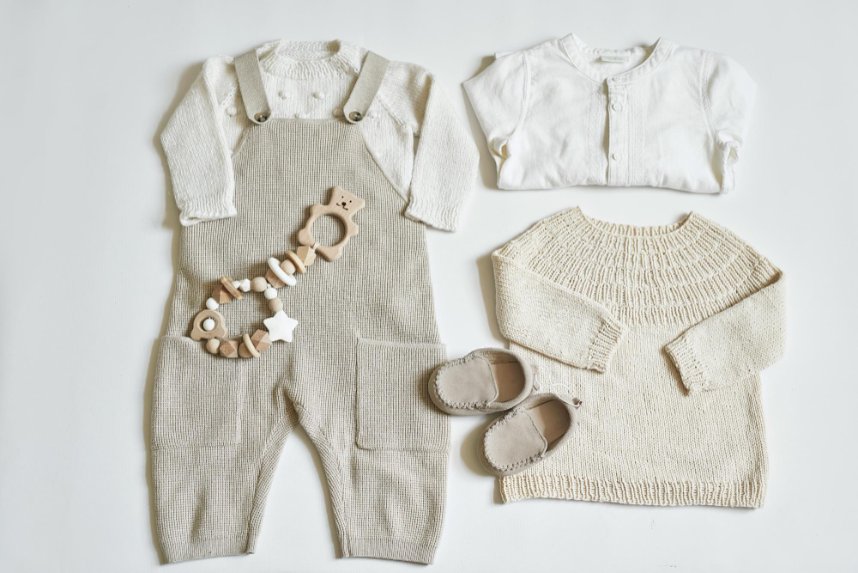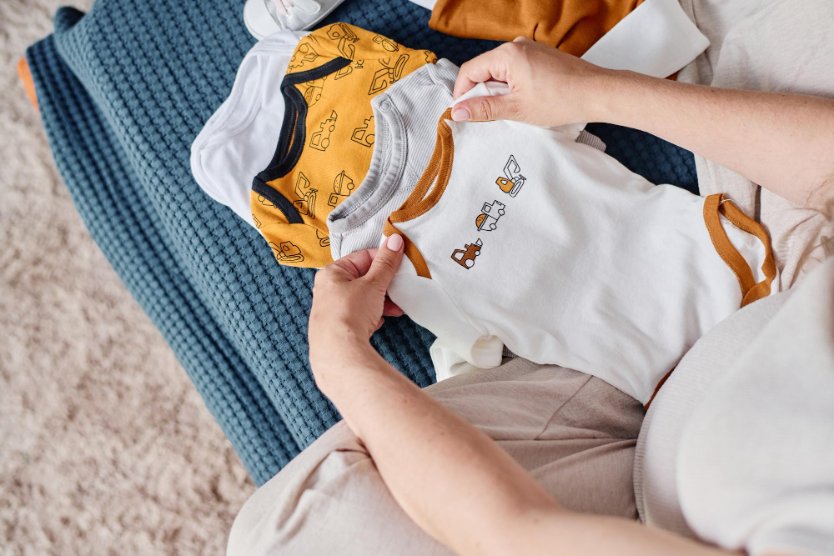Protect your baby from harmful chemicals with our evidence-based guide to PFAS-free, organic clothing and trusted certifications
🛠️ Free Tools: Use our interactive shopping checklist and chemical reference guide while shopping to ensure maximum safety.
Table of Contents
- The 2025 PFAS Crisis: What Every Parent Needs to Know
- Understanding Baby Clothes Safety
- The Basics of Organic Baby Clothing
- Certifications for Non-Toxic Clothing
- Choosing Sustainable Materials
- Smart Clothing & Technology Trends 2025
- Shopping for Safe Baby Clothes
- Practical Tips for Parents
- 2025 Safety Regulation Updates
- Budget-Friendly Safer Options
- How to Test and Identify Safe Clothing
- Frequently Asked Questions
Keeping your baby safe extends beyond the nursery – it includes the clothes they wear every day. Conventional baby clothing can contain harmful chemicals like toxic dyes and flame retardants that may affect your child’s health. The safest choice for your baby is organic clothing made from natural materials like GOTS-certified cotton, which is free from harsh chemicals and safe for sensitive skin.
The 2025 PFAS Crisis: What Every Parent Needs to Know
PFAS, known as “forever chemicals,” don’t break down naturally and can accumulate in your baby’s system. These chemicals have been linked to immune system damage, developmental delays, and hormone disruption. Here’s what you need to know:
What Are PFAS Chemicals?
Per- and polyfluoroalkyl substances (PFAS) are synthetic chemicals used to make fabrics stain-resistant, water-repellent, and wrinkle-free. They’re called “forever chemicals” because they persist in the environment and human body for decades.
How to Identify PFAS-Free Clothing
Look for these labels:
- “PFAS-free” or “PFC-free” on product tags
- Avoid items labeled “stain-resistant,” “water-repellent,” or “wrinkle-free”
- Choose natural, untreated fabrics
- Select clothing from brands that explicitly test for PFAS
💡 Pro Tip: Use our comprehensive chemical reference guide to quickly identify PFAS and other harmful chemicals on clothing labels while shopping.
Understanding Baby Clothes Safety

Babies have sensitive skin that can absorb chemicals through clothing much more easily than adults. Choosing safe fabrics helps protect your little one from exposure to toxic substances that could affect their development.
Expert toxicologist explains which baby products contain harmful chemicals and how to avoid them
Identifying Harmful Chemicals
| Chemical | Found In | Health Risks | How to Avoid |
|---|---|---|---|
| Formaldehyde | Wrinkle-resistant fabrics | Skin irritation, carcinogen | Choose natural, untreated fabrics |
| Phthalates | Printed designs, plastisol prints | Hormone disruption | Select water-based prints or plain fabrics |
| PFAS | Stain-resistant, waterproof items | Immune damage, developmental delays | Look for PFAS-free labels |
| Azo Dyes | Bright colored clothing | Cancer risk, allergic reactions | Choose naturally dyed or lighter colors |
| Heavy Metals | Dyes, metal accessories | Neurological damage | Avoid metallic elements, choose certified organic |
Health Risks of Toxic Clothing
Toxic baby clothes can cause immediate and long-term health issues. Your baby’s delicate skin absorbs chemicals more easily than adult skin, making them particularly vulnerable.
Common symptoms of chemical sensitivity include:
- Red, itchy skin or unexplained rashes
- Respiratory issues or frequent congestion
- Unexplained fussiness or behavior changes
- Sleep problems or difficulty settling
- Digestive issues (in severe cases)
⚠️ Safety First: Before shopping, download our printable safety checklist to ensure you don’t miss any critical safety indicators.
The Basics of Organic Baby Clothing
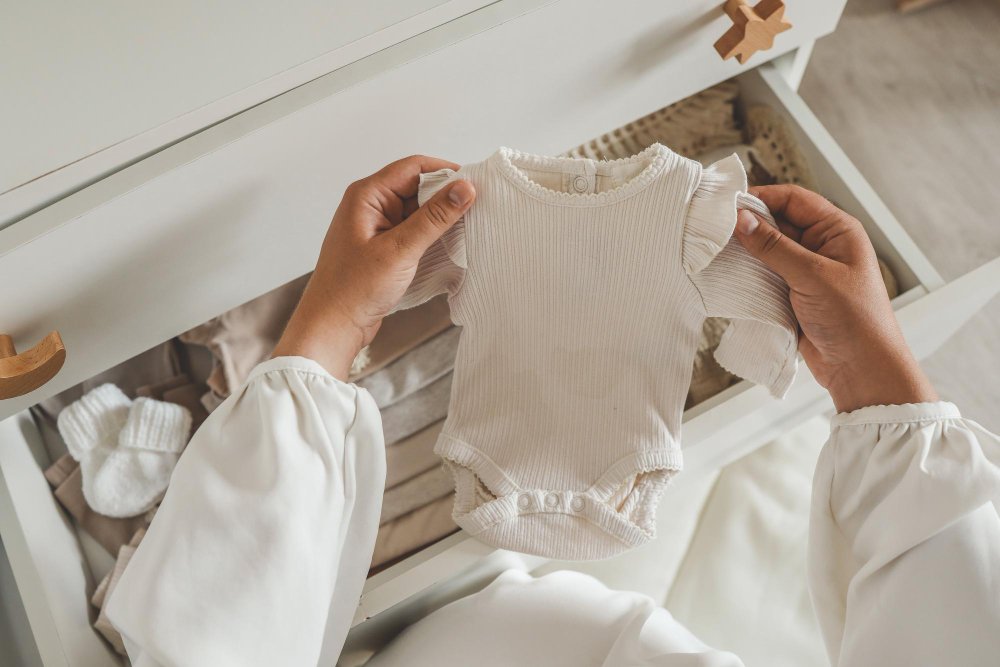
Organic baby clothes protect your little one from harmful chemicals while being gentle on sensitive skin. These garments meet strict manufacturing standards and use natural materials grown without toxic pesticides or synthetic fertilizers.
What Makes Clothes Organic
Organic cotton baby clothes are grown without toxic pesticides or synthetic fertilizers. The cotton plants must be cultivated on land that has been chemical-free for at least 3 years.
Benefits of Organic Cotton
Your baby’s skin absorbs substances more easily than adult skin. Organic cotton helps protect them from exposure to harmful chemicals while providing superior comfort.
Comfort Benefits
- Softer and more durable fabric
- Better breathability
- Gets softer with each wash
Safety Benefits
- No irritating chemical residues
- Less likely to trigger allergies
- Ideal for sensitive skin
Environmental Benefits
- Uses less water during production
- Breaks down safely when disposed
- Supports sustainable farming
Certifications for Non-Toxic Clothing
Textile certifications help you identify clothing made without harmful chemicals. These independent testing systems check for toxic substances and ensure safer manufacturing practices.
Global Organic Textile Standard (GOTS)
GOTS is the strictest certification for organic textiles. It checks the entire manufacturing process from farming to finished product.
GOTS Requirements:
- At least 95% organic fibers
- Bans toxic chemicals like formaldehyde and heavy metals
- Requires environmentally friendly processing
- Ensures fair labor practices
- Annual recertification required
OEKO-TEX Standard 100
OEKO-TEX Standard 100 uses a four-tier system to test clothing for harmful substances. Class 1, for baby clothes, has the strictest requirements.
The certification tests for over 100 harmful substances including toxic dyes, pesticides, heavy metals, and formaldehyde. Products must pass all safety tests annually to maintain certification.
Choosing Sustainable Materials
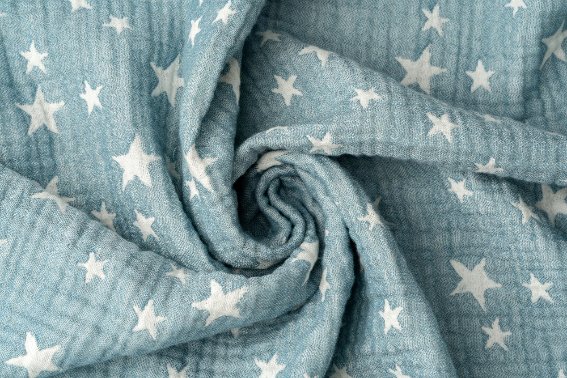
Picking the right fabric for your baby’s clothes affects both their comfort and the environment. Sustainable baby clothes use natural materials that are gentle on sensitive skin while requiring fewer resources to produce.
Natural vs. Synthetic Fabrics
Natural fibers like organic cotton and wool come from renewable sources and break down naturally. These materials let your baby’s skin breathe and prevent overheating.
| Material | Benefits | Best For | Price Range |
|---|---|---|---|
| Organic Cotton | Soft, breathable, hypoallergenic | Everyday wear, sensitive skin | $$ |
| Bamboo | Antibacterial, moisture-wicking | Hot weather, active babies | $$$ |
| TENCEL Lyocell | Silky-smooth, highly absorbent | Sleepwear, summer clothing | $$$ |
| Merino Wool | Temperature regulating, odor-resistant | Winter wear, temperature changes | $$$$ |
Smart Clothing & Technology Trends 2025
The baby clothing industry is embracing technology to create safer, more functional garments. Smart textiles are becoming increasingly popular among health-conscious parents.
Emerging Technologies
Temperature Regulation
Fabrics that adapt to your baby’s body temperature, keeping them comfortable in varying conditions.
Health Monitoring
Built-in sensors that can monitor vital signs and alert parents to potential health issues.
UV Protection
Advanced fabrics with built-in sun protection factors, eliminating the need for chemical treatments.
Safety Considerations for Smart Clothing
While smart textiles offer exciting possibilities, ensure any technology-enhanced clothing still meets basic safety standards:
- All electronic components are safely encased and washable
- Base fabric is still organic or certified safe
- No small parts that could become choking hazards
- Clear instructions for care and maintenance
Shopping for Safe Baby Clothes

Making smart choices about materials and brands helps create a safer wardrobe for your baby. Here’s how to navigate the marketplace effectively.
Recognizing Safe Baby Brands
Look for brands that prioritize transparency and safety in their manufacturing processes. Trusted organic baby clothing brands use natural materials free from harsh chemicals and unsafe dyes.
🔍 Compare Before You Buy: Use our detailed brand comparison tool to evaluate safety ratings, certifications, and prices from 18+ verified safe brands before making your purchase.
Burt’s Bees Baby
100% GOTS-certified organic cotton, transparent supply chain, affordable pricing.
Monica + Andy
Minority-founded, GOTS certified, stylish designs, beautiful packaging.
Colored Organics
GOTS certified, gives back to children in need, ethically made, sustainably produced.
Mate The Label
PFAS-free tested, non-toxic manufacturing, modern designs, transparent practices.
Pact Organic
PFAS-free verified, fair trade certified, organic cotton, competitive pricing.
Under the Nile
Egyptian organic cotton, GOTS certified, family-owned, traditional craftsmanship.
What to Look for on Labels
Safe Label Indicators:
- GOTS Certified: Gold standard for organic textiles
- OEKO-TEX Standard 100: Tested for harmful substances
- Cradle to Cradle Certified: Environmentally safe materials
- PFAS-Free or PFC-Free: No forever chemicals
- Naturally Dyed: No synthetic colorants
📋 Smart Shopping: Take our interactive shopping checklist with you to stores or bookmark it on your phone for easy reference while shopping online.
Avoiding Fast Fashion
Skip mass-produced baby clothes from unknown brands. These often contain synthetic materials and questionable dyes. Choose quality over quantity by buying fewer pieces that will last longer and wash well.
Practical Tips for Parents
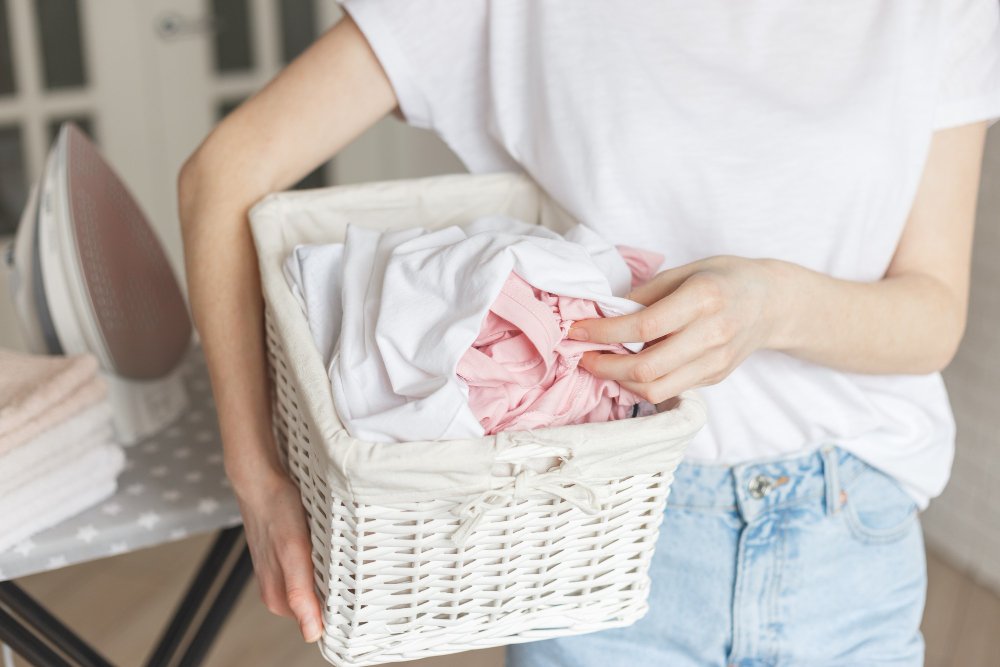
Making safe choices for your baby’s clothes requires knowing what to look for on labels and how to properly care for garments. These simple steps will protect your little one from harmful chemicals.
Reading Clothing Labels Like a Pro
Look for GOTS-certified organic cotton clothing, which ensures no toxic chemicals or dyes were used in production. Check for certifications that verify clothes are free from harmful substances.
- “Flame retardant” or “flame resistant”
- “Stain resistant” or “water repellent”
- “Permanent press” or “wrinkle-free”
- “Anti-microbial” or “antimicrobial treated”
- “Easy care” or “no-iron”
🔍 Quick Reference: Can’t remember all the chemical names? Use our searchable chemical database to instantly identify harmful substances on any clothing label.
Proper Laundering and Care
Wash all new clothes before first use to remove any residual chemicals from manufacturing. Use fragrance-free, gentle detergents made for baby clothes.
Safe Washing Practices:
- Wash new clothes 2-3 times before first wear
- Use fragrance-free, hypoallergenic detergents
- Skip fabric softeners and dryer sheets
- Wash baby clothes separately from adult clothing
- Air dry when possible for natural freshness
- Store in well-ventilated areas to prevent mildew
2025 Safety Regulation Updates
Safety regulations for children’s products are constantly evolving. Here are the key updates every parent should know about in 2025.
New Nursing Pillow Safety Standards
As of April 30, 2025, all nursing pillows must adhere to specific design standards to help prevent infant deaths. This change affects how you should evaluate all baby textile products for safety.
EU Digital Product Passports
Starting in 2025, textile products sold in the EU must include digital passports tracking materials, origin, and environmental impact. While this doesn’t directly affect US consumers, it’s pushing global brands toward greater transparency.
Stricter PFAS Testing Requirements
Several states are implementing stricter testing requirements for PFAS in children’s products. Look for brands that proactively test for and disclose PFAS levels.
Budget-Friendly Safer Options
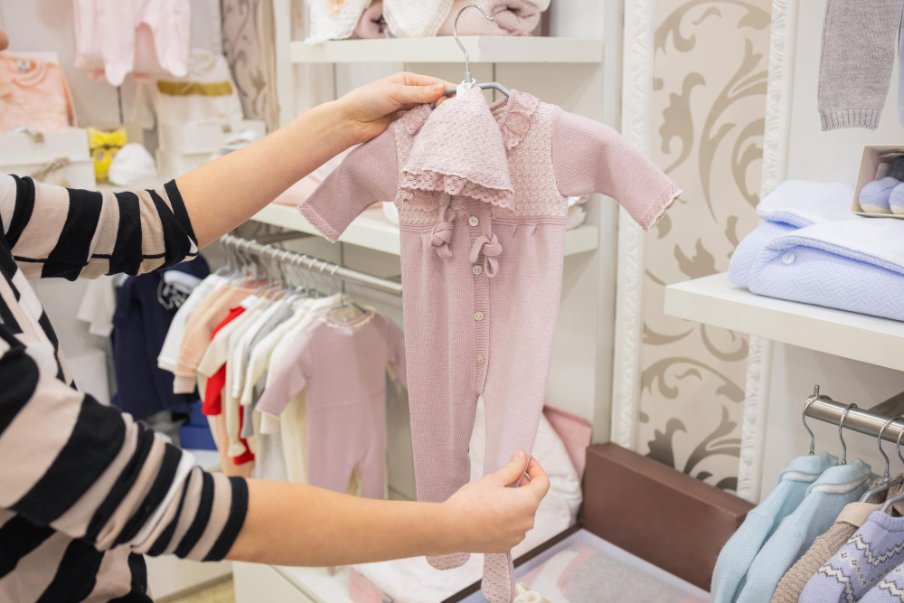
Safe baby clothing doesn’t have to break the bank. Here are strategies to protect your baby while staying within budget.
Smart Shopping Strategies
Buy Gently Used
Second-hand clothing has been washed multiple times, removing many residual chemicals.
Prioritize Key Items
Focus organic purchases on items worn closest to skin: onesies, sleepwear, underwear.
Seasonal Sales
Buy organic pieces during end-of-season sales and clearance events.
DIY Safety Improvements
You can make conventional clothing safer with these simple techniques:
- Wash new clothes 3-4 times with baking soda to remove chemical residues
- Soak items in white vinegar solution (1 cup per gallon) for 30 minutes
- Choose lighter colors and avoid bright prints when buying conventional clothes
- Remove all tags and labels that may contain formaldehyde
- Air dry in sunlight when possible for natural antibacterial benefits
How to Test and Identify Safe Clothing
What is the Safest Material for Baby Clothes?
GOTS-certified organic cotton is considered the gold standard for baby clothing safety. The best fabric for children’s clothing combines safety, comfort, and durability without harmful chemical treatments.
How to Know if Baby Clothes are Safe
How to Tell if Clothes Have Toxic Chemicals
While you can’t always detect chemicals by sight or smell, here are warning signs:
Warning Signs of Toxic Clothing:
- Strong chemical smell: New clothes with overpowering odors likely contain formaldehyde
- Stiff, plastic-like feel: May indicate chemical treatments or synthetic materials
- Bright, intense colors: Could contain azo dyes or heavy metals
- Water-repellent properties: Often treated with PFAS chemicals
- Wrinkle-free claims: Usually treated with formaldehyde
🛡️ Stay Protected: Reference our complete toxic chemicals guide to learn about all harmful substances and their health risks.
How Do I Know if My Clothes Have Formaldehyde?
Formaldehyde in clothing often has a distinct chemical smell, especially when new. Items labeled “permanent press,” “wrinkle-resistant,” or “easy care” are most likely to contain formaldehyde. Proper washing techniques can help remove some formaldehyde residues.
Can Toxins Be Washed Out of Clothes?
Some chemicals can be reduced through washing, but others like PFAS are designed to be permanent. Here’s what washing can and cannot remove:
| Chemical Type | Can Be Washed Out? | Washing Method | Effectiveness |
|---|---|---|---|
| Formaldehyde (excess) | Partially | Multiple hot washes | 60-80% reduction |
| PFAS Chemicals | No | Not removable | 0% – avoid these items |
| Excess Dyes | Partially | Cold water, vinegar rinse | 30-50% reduction |
| Pesticide Residues | Yes | Baking soda wash | 70-90% reduction |
Does Washing New Clothes Remove Chemicals?
Washing new clothes before wearing is essential. It can remove some surface chemicals, excess dyes, and manufacturing residues. However, chemicals that are bonded to fibers (like PFAS treatments) cannot be washed out.
Is Baking Soda Safe for Baby Clothes?
Yes, baking soda is safe and effective for cleaning baby clothes. Add 1/2 cup to your regular wash cycle to help neutralize odors and remove chemical residues. It’s particularly effective for removing formaldehyde and pesticide residues.
How to Disinfect Baby Clothes Naturally
Natural Disinfection Methods:
- White vinegar: Add 1 cup to rinse cycle for antibacterial properties
- Sunlight: UV rays naturally kill bacteria and viruses
- Hot water: 140°F+ kills most pathogens (check fabric care labels first)
- Steam cleaning: High-temperature steam sanitizes without chemicals
How to Get Mold Out of Baby Clothes
If you discover mold on baby clothes, act quickly:
- Brush off visible mold outdoors to prevent spore spread
- Soak in white vinegar solution (1:1 ratio) for 30 minutes
- Wash in hottest water safe for fabric with enzyme detergent
- Add 1/2 cup baking soda to wash cycle
- Air dry in direct sunlight if possible
- Check thoroughly before storing – discard if mold returns
Frequently Asked Questions
Apply the same principles: look for certifications, avoid synthetic fragrances, choose natural materials, and research brands’ safety commitments. For items like baby essentials, prioritize organic and certified safe options for anything that touches your baby’s skin.
Choose towels made from GOTS-certified organic cotton or bamboo. Avoid towels with antimicrobial treatments, synthetic fragrances, or bleaching. Look for natural, undyed options or those colored with natural dyes. OEKO-TEX certified towels are also safe choices.
All Free Clear is generally considered safer than conventional detergents as it’s fragrance-free and dye-free. However, truly organic, plant-based detergents specifically designed for babies offer the highest safety level. Always test new detergents on a small area first to check for skin reactions.
Avoid synthetic materials like polyester, nylon, and acrylic which can trap heat and moisture. Stay away from flame-retardant treated fabrics, stain-resistant materials, and anything with strong chemical odors. Conventional cotton treated with pesticides should also be avoided when possible.
Toxic clothing contains harmful chemicals like PFAS, formaldehyde, heavy metals, toxic dyes, or flame retardants. Items labeled as stain-resistant, wrinkle-free, or antimicrobial often contain these substances. Fast fashion items with unknown manufacturing standards also pose higher risks.
Look for official certifications like GOTS (Global Organic Textile Standard) or USDA Organic labels. Check the brand’s website for detailed information about their organic practices. Be wary of terms like “natural” or “eco-friendly” without certification – these aren’t regulated terms.
Poor quality baby clothing often has rough seams, loose threads, strong chemical odors, or scratchy textures. Colors may bleed when washed, and the fabric might pill or wear quickly. Check care labels – quality items usually have detailed care instructions and material composition listings.
Lead contamination in clothing typically comes from dyes or decorative elements and cannot be completely washed out. If you suspect lead contamination, it’s safest to discard the item. Always choose clothing from reputable brands that test for heavy metals, especially for items with metallic decorations or bright colors.
The Impact of the Textile Industry on Baby Safety
The textile industry’s impact on baby clothing safety extends far beyond individual garments. Understanding these broader issues helps you make informed choices that protect both your baby and the environment.
Environmental Impact of Clothing Production
The textile industry uses over 8,000 different chemicals during manufacturing, with 25% of global chemical usage coming from fashion production. Many of these substances remain in fabrics even after processing, potentially affecting your baby’s health.
Making a Positive Impact
Your clothing choices can help reduce textile pollution and demand for safer manufacturing practices. Choosing sustainable options creates market demand for cleaner production methods.
Conclusion: Building a Safer Wardrobe for Your Baby
Protecting your baby from harmful chemicals in clothing requires knowledge, vigilance, and smart shopping decisions. The 2025 PFAS crisis has highlighted the urgent need for parents to be more selective about clothing choices, but with the right information, you can create a safe, comfortable wardrobe for your little one.
Key Takeaways
- Prioritize GOTS-certified organic cotton as the safest choice for baby clothing
- Avoid PFAS-treated items completely – look for “PFAS-free” or “PFC-free” labels
- Wash all new clothes 2-3 times before first wear to remove manufacturing residues
- Choose trusted brands that prioritize transparency and safety testing
- Focus organic purchases on items worn closest to skin when budget is limited
- Read labels carefully and avoid items with chemical treatments
Action Steps for Parents
Start by auditing your current baby clothing collection. Replace items worn closest to your baby’s skin first – onesies, sleepwear, and underwear should be your top priorities for organic, certified-safe options. Building a capsule wardrobe of high-quality, safe essentials is more effective than having many lower-quality items.
🎯 Take Action Now:
- Download our complete safety checklist for your next shopping trip
- Compare trusted brands and their certifications to find the best options for your budget
- Bookmark our chemical reference guide for quick label checking
Remember that secondhand organic clothing can be an excellent budget-friendly option, as multiple washes have already removed many chemical residues. When your baby outgrows clothes, consider selling or donating to help other families access safer options.
The Future of Baby Clothing Safety
The industry is responding to parent concerns with increased transparency, better testing, and innovative materials. Smart textiles and improved manufacturing processes promise even safer options in the coming years. By supporting brands that prioritize safety and sustainability, you’re helping drive positive change for all families.
Your baby’s health is worth the extra effort and investment in safer clothing. With this guide, you’re equipped to make informed decisions that will protect your little one during their most vulnerable developmental stages. Remember, every safe choice you make contributes to a healthier future for your child and helps create demand for safer products industry-wide.
Related Articles:
Disclaimer: This article is for informational purposes only and should not replace professional medical advice. Always consult with your pediatrician if you have concerns about your baby’s health or if you notice any adverse reactions to clothing or products.
Sources:
1. American Academy of Pediatrics Environmental Health
2. Washington State Children’s Safe Products Act
3. Environmental Working Group PFAS Testing Report

